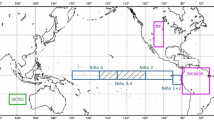Abstract
The Flexible Global Ocean-Atmosphere-Land System model, Grid-point Version 2 (FGOALS-g2) for decadal predictions, is evaluated preliminarily, based on sets of ensemble 10-year hindcasts that it has produced. The results show that the hindcasts were more accurate in decadal variability of SST and surface air temperature (SAT), particularly in that of Niño3.4 SST and China regional SAT, than the second sample of the historical runs for 20th-century climate (the control) by the same model. Both the control and the hindcasts represented the global warming well using the same external forcings, but the control overestimated the warming. The hindcasts produced the warming closer to the observations. Performance of FGOALS-g2 in hindcasts benefits from more realistic initial conditions provided by the initialization run and a smaller model bias resulting from the use of a dynamic bias correction scheme newly developed in this study. The initialization consists of a 61-year nudging-based assimilation cycle, which follows on the control run on 01 January 1945 with the incorporation of observation data of upper-ocean temperature and salinity at each integration step in the ocean component model, the LASG IAP Climate System Ocean Model, Version 2 (LICOM2). The dynamic bias correction is implemented at each step of LICOM2 during the hindcasts to reduce the systematic biases existing in upper-ocean temperature and salinity by incorporating multi-year monthly mean increments produced in the assimilation cycle. The effectiveness of the assimilation cycle and the role of the correction scheme were assessed prior to the hindcasts.
Similar content being viewed by others
References
Barnett, T., R. Malone, W. Pennell, D. Stammer, B. Semtner, and W. Washington, 2004: The effects of climate change on water resources in the west: Introduction and overview. Climatic Change, 62, 1–11.
Brohan, P., J. J. Kennedy, I. Harris, S. F. B. Tett, and P. D. Jones, 2006: Uncertainty estimates in regional and global observed temperature changes: A new dataset from 1850. J. Geophys. Res., 111, D12106, doi: 10.1029/2005JD006548.
Cherupin, G. A., J. A. Carton, and D. Dee, 2005: Forecast model bias correction in ocean data assimilation. Mon. Wea. Rev., 133, 1328–1342.
Dee, D. P., 2005: Bias and data assimilation. Quart. J. Roy. Meteor. Soc., 131, 3323–3343.
Ishii, M., M. Kimoto, K. Sakamoto, and S. I. Iwasaki, 2006: Steric sea level changes estimated from historical ocean subsurface temperature and salinity analyses. Journal of Oceanography, 62(2), 155–170.
Keenlyside, N. S., M. Latif, J. Jungclaus, L. Kornblueh, and E. Roeckner, 2008: Advancing dedadal-scale climate prediction in the North Atlantic sector. Nature, 453, 84–88.
Li, H. M., A. G. Dai, T. J. Zhou, and J. Lu, 2010: Responses of East Asian summer monsoon to historical SST and atmospheric forcing during 1950–2000. Climate Dyn., 34, 501–514.
Li, L. J., X. Xie, B. Wang, and L. Dong, 2012a: Evaluating the performances of GAMIL1.0 and GAMIL2.0 during TWP-ICE with CAPT. Atmos. Oceanic Sci. Lett. 5, 38–42.
Li, L. J., and Coauthors, 2013a: Evaluation of grid-point atmospheric model of IAP LASG, version 2.0 (GAMIL 2.0). Adv. Atmos. Sci., doi: 10.1007/s00376-013-2157-5.
Li, L. J., and Coauthors, 2013b: The flexible global ocean-atmosphere-land system model, grid-point version 2: FGOALS-g2. Adv. Atmos. Sci., doi: 10.1007/s00376-012-2140-6.
Liu, H. L, P. F. Lin, Y. Q. Yu, and X. H. Zhang, 2012: The baseline evaluation of LASG/IAP climate system ocean model (LICOM) version 2.0. Acta Meteorologica Sinica., 26(3), 318–329, doi: 10.1007/s13351-012-0305-y.
Meehl, G. A., and Coauthors, 2009: Decadal prediction: Can it be skillfull? Bull. Amer. Meteor. Soc., 90, 1467–1485.
Mochizuki, T., and Coauthors, 2010: Pacific decadal oscillation hindcasts relevant to near-term climate prediction. PNAS, 107, 1833–1837, doi: 10.1073/pnas.0906531107.
Pierce, D. W., T. P. Barnett, R. Tokmakian, A. Semtner, M. Maltrud, J. Lysne, and A. Craig, 2004: The ACPI project, element 1: Initializing a coupled climate model from observed conditions. Climatic Change, 62, 13–28.
Pohlmann, H, J. H. Jungclaus, A. Köhl, D. Stammer, and J. Marotzke, 2009: Initializing decadal climate predictions with the GECCO oceanic synthesis: Effects on the North Atlantic. J. Climate, 22, 3926–3938.
Rayner, N. A., D. E. Parker, E. B. Horton, C. K. Folland, L. V. Alexander, D. P. Rowell, E. C. Kent, and A. Kaplan, 2003: Global analyses of sea surface temperature, sea ice, and night marine air temperature since the late nineteenth century. J. Geophys. Res., 108(D14), 4407, doi: 10.1029/2002JD002670.
Schneider, E. K., B. Huang, Z. Zhu, D. G. Dewitt, J. L. Kinter III, B. P. Kirtman, and J. Shukla, 1999: Ocean data assimilation, initialization, and predictions of ENSO with a coupled GCM. Mon. Wea. Rev., 127, 1187–1207.
Smith, D.M., S. Cusack, A. W. Colman, C. K. Folland, G. R. Harris, and J. M. Murphy, 2007: Improved surface temperature prediction for the coming decade from a global climate model. Science, 317, 796–799.
Troccoli, A., and T. N. Palmer, 2007: Ensemble decadal prediction from analysed initial conditions. Phil. Trans. Roy. Soc. A, 365, 2179–2191.
Wang, B., H. Wan, Z. Z. Ji, X. Zhang, R. C. Yu, Y. Q. Yu, and H. L. Liu, 2004: Design of a new dynamical core for global atmospheric models based on some efficient numerical methods. Science in China (A), 47, 4–21.
Wang, B., X. Xie, and L. J. Li, 2009: A review on some aspects of climate simulation evaluation. Adv. Atmos. Sci., 26(4), 736–747, doi: 10.1007/s00376-009-9038-y.
Wang, X., 2009, Improvements in sea ice component of IAP/LASG climate system model, M.S. thesis, Chinese Academy of Sciences, 101pp. (in Chinese)
Zhang, S., 2011: Impact of observation-optimized model parameters on decadal predictions: Simulation with a simple pycnocline prediction model. Geophys. Res. Lett., 38, L02702, doi: 10.1029/2010GL046133.
Author information
Authors and Affiliations
Corresponding author
Rights and permissions
About this article
Cite this article
Wang, B., Liu, M., Yu, Y. et al. Preliminary evaluations of FGOALS-g2 for decadal predictions. Adv. Atmos. Sci. 30, 674–683 (2013). https://doi.org/10.1007/s00376-012-2084-x
Received:
Revised:
Published:
Issue Date:
DOI: https://doi.org/10.1007/s00376-012-2084-x




